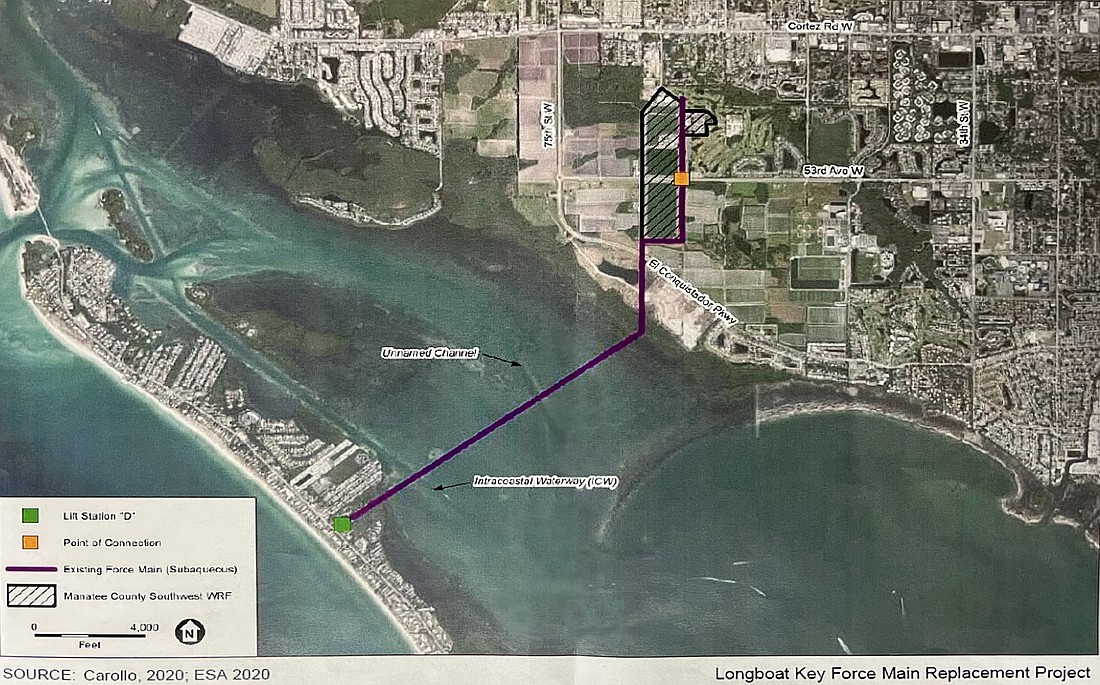- April 23, 2024
-
-
Loading

Loading

After six months of construction, Murphy Pipeline Contractors has fully replaced the mainland portion of the town of Longboat Key’s subaqueous force main, and the pipeline is now operational.
The force main conveys wastewater to Manatee County’s treatment facility 4 miles away.
The old pipe still remains in place because the town opted to slip-line the new pipe into the existing one, which was more economical and efficient than running a new pipe parallel to the old one. The newly installed pipe is expected to last between 75 to 100 years.
The old pipe measures about 20 inches in diameter, whereas the newly inserted one is 18 inches in diameter.
About 1.2 miles of the pipeline have been relined with the new, upgraded material. The mainland portion started at the June 2020 leak repair point, which is about 400 feet north of Sarasota Bay, to the Manatee County meter located at the county’s Southwest Water Reclamation Facility.
The project’s cost came in at about $2.6 million. The majority of those costs, $2 million, was covered by state appropriations received over the last two years as part of a broader effort to improve the sewer main.
The project kept on schedule, with initial work starting in November 2022. The most recent phase was started in March, following an access agreement that allowed the town to complete the slip-lining process to the Long Bar Pointe property.
The mainland portion of the sewer project is one of two projects working toward replacing the town’s sewer main after a break occurred in June 2020, spilling millions of gallons of effluent in Manatee County.
Originally, town staff planned for a brand-new pipe to run parallel to the existing pipe, which went into service in the 1970s. The original pipe was built with the expectation of Longboat Key’s population one day exceeding 50,000 residents. A 1984 decision to rezone the island changed the trajectory of island growth, limiting peak season population to about half that number.
The final portion of the pipeline has not been started yet because the town is awaiting additional funding. The last section will be the most expensive and difficult portion of the project because the remainder of the pipe runs under Sarasota Bay.
A few approaches have been considered to build a redundant pipe across the bay, including the most aggressive approach, open cutting. Open cutting is a method of pipeline installation that requires digging up the underwater bed of Sarasota Bay to the required depth for installing the pipe.
According to the American Concrete Pressure Pipe Association, installing a pipe underwater includes three steps that are also used on land, including trench excavation, pipe laying and backfilling. Going through water increases the difficulty compared with traditional land installation.
When excavating, a backhoe can be used if waters are relatively stable and depths are not excessive. Then bedding material such as sand or crushed stone is placed in the excavated trench to ensure the pipe will stay where it is placed and maintain the required height. Finally, the pipe is placed with the help of construction divers to guide it into position.
The town received $3 million in federal grants in February towards the project. The total project, including the mainland portion, is anticipated to cost about $21.7 million. The subaqueous portion will make up about $19 million of the total cost.
Final permits for the project have already been acquired from the Florida Department of Environmental Protection and United States Army Corps of Engineers. The final design of the project is anticipated in fiscal year 2024, which starts in October. A final construction schedule for the remaining portion has not been set.